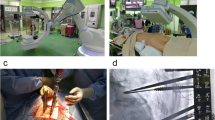Abstract
Study Design
Retrospective review of magnetic resonance imaging (MRI) and computed tomographic (CT) scan imaging modalities.
Objective
To determine MRI’s capability of identifying pedicle morphology.
Summary of Background Data
Understanding pedicle morphology is important for accurate placement of pedicle screws. The gold standard modality to assess pedicle morphology is CT scan. However, CT scans carry the risk of radiation exposure. We have studied MRI as a potential alternative to CT scan.
Methods
Nine hundred seventy pedicles in 33 spinal deformity patients were reviewed. Pedicle morphology was classified as follows: Type A (normal pedicle): >4-mm cancellous channel; Type B: 2–4-mm channel; Type C: any size cortical channel; and Type D: <2-mm cortical or cancellous channel. Pedicles in the same patients were classified on both low-dose CT scan and MRI. Concordance and discordance rates of MRI relative to CT scan in classification of pedicles into types A, B, C, and D were calculated for the entire length of the thoracolumbar spine and subgrouped into spinal sections. All images were evaluated by a single fellowship-trained musculoskeletal radiologist.
Results
CT scan had 809 Type A, 126 Type B, 29 Type C, and 6 Type D pedicles. Group II (MRI) had 735 Type A, 203 Type B, 30 Type C, and 2 Type D pedicles. Analysis of the entire spinal column showed a concordance rate of 86.7% in classification of the pedicles into the 4 types. In the upper thoracic region, the concordance rate was 77.1%, main thoracic 85.5%, thoracolumbar 96%, and lumbar 98.1%. MRI has a poor overall accuracy for detecting Type C pedicles, only a 44.8% concordance with CT scan. MRI overcalls Type B pedicles, often calling Type A pedicles Type B.
Conclusions
MRI is an inferior alternative to CT scan as it has poor accuracy to properly detect pedicle abnormalities. The more severe the pedicle abnormality, the less diagnostic value the MRI has.
Level of Evidence
Level III, diagnostic
Similar content being viewed by others
References
Weinstein JN, Rydevik BL, Rauschning W. Anatomic and technical considerations of pedicle screw fixation. Clin Orthop Relat Res 1992;284:34–46.
Zindrick MR, Wiltse LL, Widell EH, et al. A biomechanical study of intrapeduncular screw fixation in the lumbosacral spine. Clin Orthop Relat Res 1986;203:99–112.
Ebraheim NA, Jabaly G, Xu R, Yeasting RA. Anatomic relations of the thoracic pedicle to the adjacent neural structures. Spine (Phila Pa 1976) 1997;22:1553–6; discussion 1557.
Vanichkachorn JS, Vaccaro AR, Cohen MJ, Cotler JM. Potential large vessel injury during thoracolumbar pedicle screw removal. A case report. Spine (Phila Pa 1976) 1997;22:110–3.
Sarwahi V, Sugarman EP, Wollowick AL, et al. Prevalence, distribution, and surgical relevance of abnormal pedicles in spines with adolescent idiopathic scoliosis vs. no deformity: a CT-based study. J Bone Joint Surg Am 2014;96:e92.
Author information
Authors and Affiliations
Corresponding author
Additional information
Author disclosures: VS (other from Medtronic, other from Precision Spine, outside the submitted work); TA (none); SW (none); RG (none); ES (none); YL (none); DW (none); BT (none).
Rights and permissions
About this article
Cite this article
Sarwahi, V., Amaral, T., Wendolowski, S. et al. MRIs Are Less Accurate Tools for the Most Critically Worrisome Pedicles Compared to CT Scans. Spine Deform 4, 400–406 (2016). https://doi.org/10.1016/j.jspd.2016.08.002
Received:
Revised:
Accepted:
Published:
Issue Date:
DOI: https://doi.org/10.1016/j.jspd.2016.08.002




